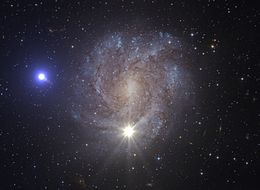US 708
US 708| 관찰 데이터 Epoch J2000 Equinox J2000 | |
|---|---|
| 콘스텔레이션 | 큰곰자리 |
| 적경 | 09h 33m 20.865s[1] |
| 적위 | +44°17°05.52°[1] |
| 겉보기 등급(V) | 18.8[1] |
| 특성. | |
| 스펙트럼형 | sdOHe[1] |
| 아스트로메트리 | |
| 반지름 속도(Rv) | 708.0 ± 15.0[2] km/s |
| 고유운동(μ) | RA: - 7.33 ± 0.58[2] mas/년 Dec.: 2.28 ± 0.55[2] mas/년 |
| 거리 | 60,300 ± 8,500 ly (18,500 ± 2,600[2] pc) |
| 상세[2] | |
| 표면 중력(log g) | 5.23 ± 0.12 kg |
| 온도 | 44561 ± 675 K |
| 기타 명칭 | |
SDSS J093320.86+441705.4 | |
| 데이터베이스 참조 | |
| 심바디 | 데이터. |
US 708은 우리은하의 후광에 있는 큰곰자리 O급 준왜성이다.은하계에서 가장 빠르게 움직이는 별 중 하나인 이 별은 1982년에 [3][4][5]처음 조사되었다.
검출
US 708은 1982년 피터 어셔와 펜실베니아 주립 대학의 동료들에 의해 은하수 후광에 있는 희미한 푸른 물체로 처음 발견되었다.Sloan Digital Sky Survey는 2005년에 [6]이 별을 다시 측정했다.
조사.
2015년 유럽남부천문대의 스테판 가이어는 사이언스에 이 별의 속도가 1,200km/s(4,300,000km/h; 2,700,000mph)로 [3][7][8]은하계에서 기록된 최고라고 보고했다.이 별의 빠른 속도는 원래 은하 중심에 있는 거대한 블랙홀 때문에 생긴 것으로 추정되었다.그러나 이제 이 별은 약 1400만년 전에 은하 원반을 가로지른 것이 분명하며, 따라서 은하 중심에서 온 것이 아니라는 것이 밝혀졌습니다. 따라서 현재 이 별이 가지고 있는 [9]속도는 블랙홀에 기인하지 않을 수도 있습니다.하지만, 더 자세한 연구에 따르면 그것은 가까운 [10]쌍성 한 쌍의 원소 중 하나였다고 한다.
동반성은 US 708이 적색거성 단계에 접어들었을 때 이미 백색왜성 단계에 진입한 상태였다.동반자가 US 708의 바깥쪽 층에서 가스를 흡수하면서 각각의 궤도가 바뀌었다.그 후 이 동반성은 초신성을 일으킬 수 있는 충분한 질량을 얻었고, 이로 인해 US 708은 [11]우리 은하 중심에 있는 블랙홀이 아닌 빠른 속도로 날아갔다.이 새로운 관측을 뒷받침하는 팀은 이 행성이 공전 주기가 [7][8]10분 미만인 태양 질량의 백색왜성을 공전하고 있었다는 것을 시사한다.
구조.
이 별은 빠른 속도로 회전하고 밀도가 높은 헬륨 별이며 근처에 있는 동반성의 상호작용에 의해 형성되어야 합니다.이 별들은 수소 봉투를 잃은 거대한 별의 잔해인 헬륨으로 구성되어 있다.가이어의 팀은 이 별을 "은하에서 가장 빠른 결합 별"이라고 묘사하고 [12]하와이에 있는 10미터 멕 II 망원경에 부착된 에셸레트 분광기와 이미저를 사용했다.그것의 속도는 우리 [13]은하의 탈출 속도를 초과합니다.
레퍼런스
- ^ a b c d "US 708". SIMBAD. Centre de données astronomiques de Strasbourg. Retrieved 28 November 2016.
- ^ a b c d e Brown, Warren R.; Anderson, Jay; Gnedin, Oleg Y.; Bond, Howard E.; Geller, Margaret J.; Kenyon, Scott J. (2015). "Proper Motions and Trajectories for 16 Extreme Runaway and Hypervelocity Stars". The Astrophysical Journal. 804 (1): 49. arXiv:1502.05069. Bibcode:2015ApJ...804...49B. doi:10.1088/0004-637X/804/1/49. S2CID 15799814.
- ^ a b Stephan Geier; F. Fürst; E. Ziegerer; T. Kupfer; U. Heber; A. Irrgang; B. Wang; Z. Liu; Z. Han; B. Sesar; D. Levitan; R. Kotak; E. Magnier; K. Smith; W. S. Burgett; K. Chambers; H. Flewelling; N. Kaiser; R. Wainscoat; C. Waters (2015-03-06). "The fastest unbound star in our Galaxy ejected by a thermonuclear supernova". Science. Science magazine. 347 (6226): 1126–8. arXiv:1503.01650. Bibcode:2015Sci...347.1126G. doi:10.1126/science.1259063. PMID 25745168. S2CID 206561078.
Hypervelocity stars (HVSs) travel with velocities so high that they exceed the escape velocity of the Galaxy.
- ^ Eric Mack (2015-03-08). "'Shrapnel' Star Sets Milky Way Speed Record". Forbes magazine. Retrieved March 11, 2015.
- ^ "Thermonuclear supernova ejects galaxy's fastest star". Astronomy magazine. 2015-03-09. Retrieved 2015-03-11.
Scientists using the W. M. Keck Observatory and Pan-STARRS1 telescopes on Hawaii have discovered a star that breaks the galactic speed record, traveling with a velocity of about 2.7 million mph (1,200 km/s). This velocity is so high, the star will escape the gravity of our galaxy. In contrast to the other known unbound stars, the team showed that this compact star was ejected from an extremely tight binary by a thermonuclear supernova explosion.
- ^ "US 708: Hypervelocity Star Ejected by Supernova Breaks Galactic Speed Record". Science News. 2015-03-06. Retrieved 2015-03-10.
A multinational team of astronomers led by Dr Stephan Geier from the European Southern Observatory in Garching, Germany, has determined that a hypervelocity star known as US 708 is traveling at about 1,200 km per second.
- ^ a b "Fastest Star in Our Galaxy Propelled by a Thermonuclear Supernova". Institute for Astronomy, University of Hawaii. Retrieved March 11, 2015.
- ^ a b John Timmer (March 5, 2015). "Fastest star leaving our galaxy was blasted out by a supernova: A double-detonation supernova spits out a hypervelocity hot dwarf". Arstechnica. Retrieved March 11, 2015.
- ^ Douglas Quenqua (2015-03-10). "Fastest Star in the Galaxy Got an Unusual Start". New York Times. p. D4. Retrieved 2015-03-10.
By measuring the velocity, trajectory and rotation of the star, known as US 708, researchers at the European Southern Observatory determined that it started life as one half of a close binary pair — two stars that closely orbited one other.
- ^ "IflScience". Retrieved March 11, 2015.
- ^ "TechTimes". 6 March 2015. Retrieved March 11, 2015.
- ^ "DNews". Archived from the original on May 12, 2015. Retrieved March 11, 2015.
- ^ "Thermonuclear Supernova Ejects Galaxy's Fastest Star". KeK. Archived from the original on June 6, 2018. Retrieved March 11, 2015.






